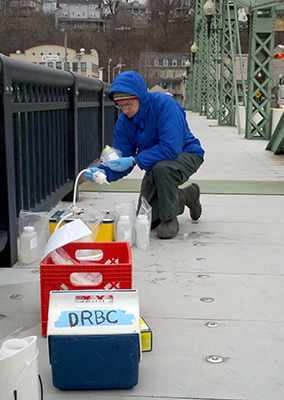Delaware • New Jersey • Pennsylvania
New York • United States of America
- Aquatic Life Designated Use Project
- Bacteria Monitoring
- Biomonitoring Program
- Chlorides Monitoring
- Contaminants of Emerging Concern
- Delaware Estuary Water Quality Monitoring Program
- Dissolved Oxygen and Nutrients
- Modeling
- Other Monitoring (e.g., Toxicity, Fish Tissue, Metals)
- PCBs and PMPs
- Special Protection Waters (SPW)
- Water Resource Data Sets
 |
| DRBC staff monitoring metals. Photo by DRBC. |
Examples of Metals & Aquatic Life Impacts
Copper is a naturally occurring trace element found in surface waters and, while essential to virtually all plants and animals, it can be toxic to aquatic life even in low concentrations.
Aluminum is the most common metal in the earth’s crust, and natural sources include the weathering of rocks. Other sources include mining, industrial processes, and wastewater treatment with alum. It can inhibit respiration by binding to ion channels, interfering with essential element uptake, or by accumulating on gills.
The release of metals to the environment and impacts on aquatic life have long been concerns for the public and regulators.
Monitoring for Metals
DRBC monitors metals, such as copper, aluminum, zinc, nickel, chromium (VI) and mercury, in ambient water, sediment and tissues of aquatic life of the Delaware Estuary to ensure compliance with water quality criteria.
The generation of appropriate regulatory procedures requires a sound understanding of the chemistry, toxicology and fate of metals in the environment.
Bioavailability, bioaccumulation and toxicity of metals can be strongly influenced by the presence of complexing and competing ligands, as well as organism-specific characteristics (e.g., physiology, feeding and exposure route), complicating the assessment of hazard and risk from metals.
Water quality assessment of metals is also complicated by factors such as field sampling techniques, analytical issues with contamination, detection limits associated with routine analytical procedures and the applicability of freshwater or marine criteria in the river's estuarine waters.
Looking Ahead
The DRBC will continue to coordinate with the Basin states, USEPA and stakeholders on criteria development, monitoring and assessment of metals to ensure the use of the most appropriate methods and procedures for the conduct of monitoring studies in the Basin and to ensure the harmonization of water quality criteria and assessment methodologies for metals.
Resources
- Assessment of Metals in Estuarine Waters (pdf 884 KB; DRBC presentation given at the January 2013 Partnership for the Delaware Estuary Science Summit)
- Clean Hands Metals Sampling Techniques (pdf 202 KB; DRBC poster presented at the January 2013 Partnership for the Delaware Estuary Science Summit)
Examples of Sampling Efforts
- Assessment of Metals in Estuarine Waters - In Zone 5 of the Delaware River, which extends from the Pa.-Del. state line south to Liston Point, copper concentrations continue to be near water quality criteria with several apparent exceedances of the marine criteria in the vicinity of Pea Patch Island, Delaware. In 2012, the DRBC performed additional data collection for copper, zinc and nickel using enhanced analytical methods and modified collection procedures in this section of the Delaware River. The technique used is called "Cleans Hands/Dirty Hands" and results in very low contamination of the sample by other metal sources. The information collected as part of this study will provide additional data to help determine metals concentrations in ambient water and whether the commission's metal criteria are exceeded.
- Lower Delaware River Metals Sampling - The DRBC's Toxics Advisory Committee has recommended that the DRBC adopt toxics criteria for the non‐tidal Delaware River. In 2012, a project plan was developed for sampling 13 sites for metals and supplemental physical-chemical data; sampling began in January 2013. The resultant data from this monitoring effort will inform a sound technical approach for developing protective and applicable water quality criteria for metals in these non-tidal freshwaters.
Related Info
Copyright © Delaware River Basin Commission,
P.O. Box 7360, West Trenton, NJ 08628-0360
Phone (609)883-9500; Fax (609)883-9522
Thanks to NJ for hosting the DRBC website